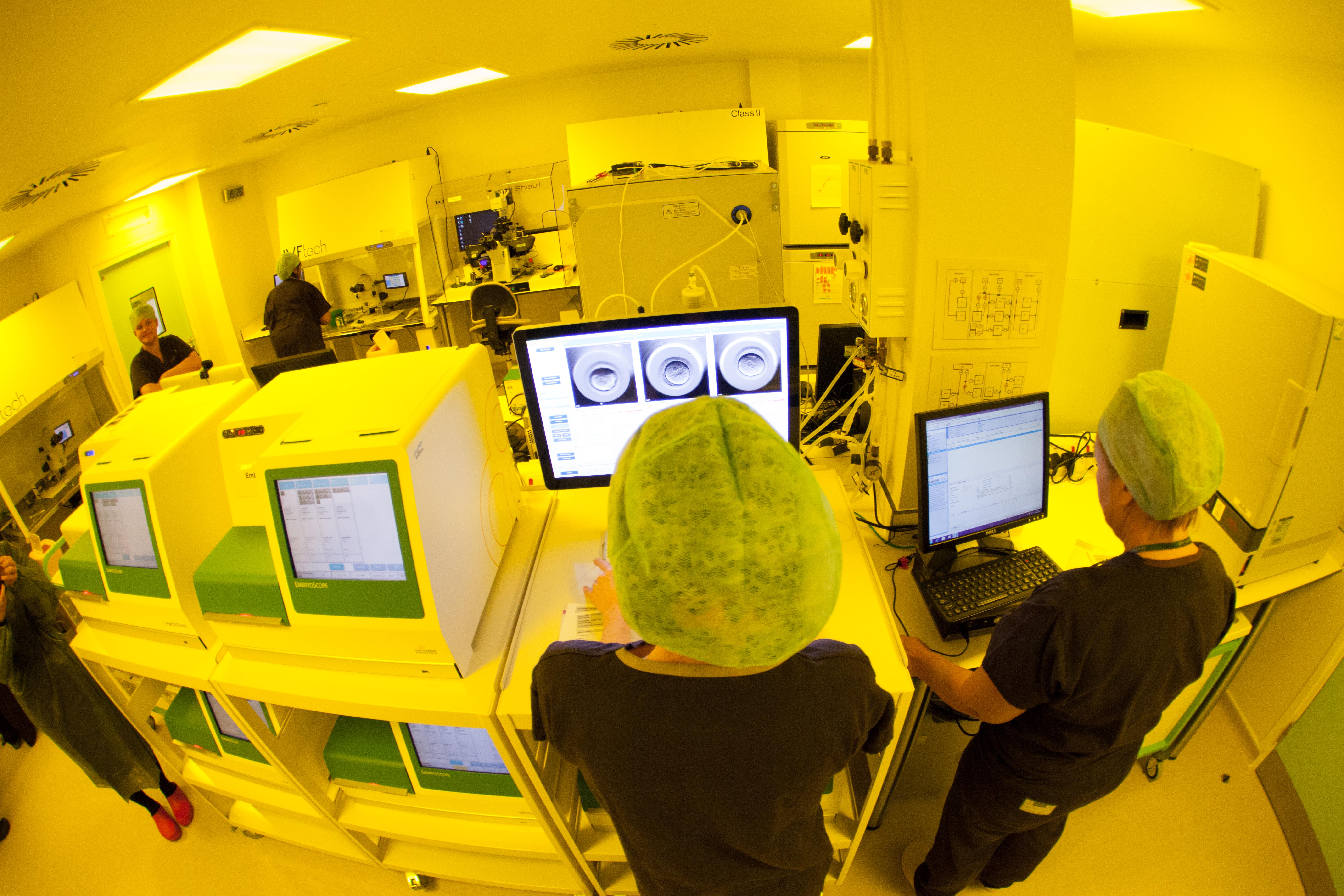
Nothing outdated, but everything updated
Are any fertility treatments out of date? To put it simply, no, but that isn’t to say that treatment is just as it was 40 years ago. While the treatment you receive today will involve the same steps as were involved in the 70’s, the efficiency, safety, rate of success and affordability have all greatly improved.
How has IVF changed?
In the early days, IVF treatment was an intensive experience for the patient. They would need to be hospitalised for the duration of the cycle in order to monitor hormone levels. This was done by collecting all of the patient’s urine, analysis of which would tell the clinicians exactly when a woman was ovulating and when egg collection would have to take place. This would sometimes mean collection would take place in the early hours of the morning or very late at night.
Thanks to advancements in drugs that can control a woman’s ovulation, IVF patients are able to be at home and work while undergoing treatment cycles. These drugs allow scheduling the egg retrievals at more normal hours of the day, also allowing doctors to have more control of the entire ovulation process, increasing the chances of success.
In the beginning, egg retrieval required invasive surgery, general anaesthetic, as well as all of the subsequent discomfort and anxieties that go along with surgery. Today, an ultrasound-guided needle is used to retrieve the eggs while the patient is awake. This is significantly less invasive, less risky, and involves a shorter recovery time. Most women can usually go home shortly afterwards.
Success Rates
In the early nineties, the success rates for IVF were 15% or lower. When you take into consideration that fertility treatments at that time were considerably more expensive and multiple attempts were rare, having a 15% chance or less was a big gamble. That being said, even years after the first successful IVF treatment scientists and doctors were still learning about the limitations and functionality of the process.
These days, things are a lot more reliable. Some statistics show that a woman of 35 or under has around a 40% chance of becoming pregnant after just one cycle of IVF, and those numbers continue to increase. The past decade has again seen a rise of 2% in global success rates and, while that might not seem like a massive number, a 2% improvement in all successful procedures worldwide could account for thousands of successful pregnancies.
New technologies creating opportunities for many more
One of the biggest contributing factors to the increased success, accessibility and reliability of fertility treatment is the numerous discoveries and advancements made in the fields of Gynaecology, Embryology, Andrology (The study of conditions that effect male fertility) and Endocrinology (The study of hormones).
- Egg freezing/Vitrification
Egg freezing is a revolutionary technology that allows mature eggs to be frozen and stored for later use. Initially developed as a means to 'preserve' the fertility of women ahead of cancer treatment, it’s now increasingly used by women wishing to protect their fertility for a variety of ‘social’ reasons. Since we know that a woman’s fertility – including her ovarian reserve and egg quality – declines with age, elective egg freezing offers one option to those wishing to conceive later.
Originally, egg freezing was - like most other medical advancements – inconsistent, and often the egg or embryo would not survive the freezing process. Vitrification, literally meaning “frozen in glass”, allowed embryologists to extract water from the eggs before freezing them very quickly; thus protecting them from the damage that would occur from water crystals building up inside.
The first baby conceived from a 'vitrified' egg was born in 2010. Since then the procedure has moved ahead rapidly, for both medical and non-medical reasons. Many women are now taking up the option of “Social Freezing” and embracing the freedom of choice that egg freezing offers women who may not wish to make the sacrifices in their career or social life having a child may require. In 2014 Apple and Facebook announced that they would cover the cost of egg freezing for their female employees, catapulting discussions of egg freezing into the popular media.
- ICSI
By now most people are familiar with IVF, the process of fertilising eggs in a lab and placing them inside a woman’s uterus for development. As mentioned, this procedure is not guaranteed to lead to pregnancy and for some women, more intervention is needed; this is where ICSI is important.
In traditional IVF treatment, an egg and sperm are placed in a medium that replicates the conditions of a woman’s uterus and allowed time in an incubator to fertilise of their own volition. This process remains the most common treatment for fertility issues however, for couples dealing with complications such as low sperm mobility or low sperm count normal IVF can be insufficient.
Intracytoplasmic Sperm Injection, or ICSI, was first carried out successfully in 1992 and involves an embryologist using a very fine needle and powerful microscopes to isolate a single sperm cell, stun it temporarily, draw it up into the needle and then inject it directly into the egg. ICSI is beneficial to those with more severe fertility issues as it does not require thousands of healthy, mobile sperm cells; as is needed for successful IVF.
- EmbryoScope
During IVF or other similar fertility treatments, the incubation of the embryo is the most crucial stage in ensuring a successful pregnancy. In the past, incubation meant holding the embryo in large refrigeration units and sporadically removing them to be analysed under a microscope before quickly placing them back into incubation.
This process was not ideal. The repetitive changes in temperature would often have a detrimental effect on the embryo, leading to more occurrences of embryo’s becoming unviable and having to be disposed of. For women with a low ovarian reserve, or those using donor eggs, this can mean their already slim chances of successful pregnancy are lost.
An additional reason why this old method of incubation was imperfect was that, while the embryos were stored in the refrigeration units, the embryologists were unable to monitor their development. This would mean that abnormalities and even the death of the embryo could occur unnoticed until the embryologist was able to perform an analysis under the microscope.
Thankfully, in 2009, the EmbryoScope was invented. The EmbryoScope is a revolutionary incubator that allows embryos to be monitored 24/7 without ever having to be removed from incubation.
A self-contained refrigeration unit with a built in monitoring system allows embryologists to take pictures of developing embryo’s every hour, which are then displayed on a monitor allowing a scientist to analyse and compare. Embryologists can then ensure they are able to spot any abnormalities in embryo development, as well as having the best information possible when deciding on which embryo to implant into the patient to give the best chance of a successful, healthy pregnancy.
Looking to the future
- Advanced genetic screening
The genetic testing of embryos before implantation (Pre-implantation Genetic Diagnosis, or PGD) is already widely used by most fertility clinics all over the world. This helps to prevent a number of genetic disorders such as Sickle-Cell Disease and Muscular Dystrophy. These technologies are developing every day and many believe that gene therapy and genetic science will be at the forefront of medicine in years to come. The ability to eradicate genetic abnormalities, from severe conditions such as Down's Syndrome right through to more commonplace genetic condition such as psoriasis, is a possibility in the not-to-distant future, thanks to advancements in the field of genetics.
While many people will welcome the arrival of such technologies, debates are already being held about the moral implications of such advancements. The idea of “Designer babies” and even more serious overtones of Eugenics are all factors being discussed and some countries such as Germany have already outlawed genetic screening in all but the most serious of cases.
- Three parent embryos
This procedure is the next step for fertility science. Already successfully trialled in Mexico and receiving parliamentary approval in the UK in 2017, the technology involves replacing what’s known as the Mitochondria of the cell. Mitochondria are the powerhouse of the cell, small “batteries” that give the cell energy as they develop. Unfortunately, some people suffer from a genetic abnormality that causes the mitochondria to be damaged; this can lead to severe genetic conditions in children, possible even leading to miscarriage, stillbirth or infant mortality.
What three-person fertilisation entails is the replacement of the damaged mitochondria with that of a healthy, donor egg. This procedure is beneficial because, not only does it greatly reduce the chances of genetic diseases, but also ensures that the nucleus of the parent cell - the part of the cell that contains the DNA - remains intact. This means that the child born as a result of the treatment will be genetically linked to the parent and will inherit their attributes. Currently, women that use donor cells due to having unsuitable eggs or no eggs of their own, have to accept the sometimes uncomfortable reality of giving birth to, and raising a child that will be genetically different to themselves and not possess their hereditary attributes such as hair or eye colour; advancements in mitochondrion replacement technology can offer and alternative to this.
- Womb transplants
This “future technology” was actually successfully completed in Sweden back in 2015, however, up until very recently it remained the only successful case of a Uterine Transplantation leading to a successful birth. Only one other case has ever been reported in November 2017 in Texas, USA. The procedure is currently not practiced in the UK but efforts are being made to establish clinical trials.
Womb transplants, or Uterine Transplants, could offer a solution to the 1 in 4,500 women who are born without a uterus, as well as offering a lifeline to women who have had to have their uterus removed due to cancer. In future, it is hoped that the uterus from a donor or deceased woman could be safely transplanted into a recipient, enabling them to undergo a natural pregnancy and hopefully leading to a healthy birth.




